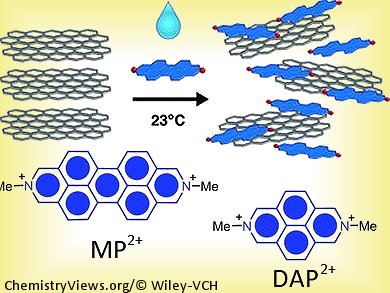The quantity and quality of graphene directly impacts its performance and its applications, such as in organic field-effect transistors, conductive materials, photovoltaics, and in biological applications. Physical methods to make graphene give high-quality graphene in limited amounts at high cost. Chemical oxidation of graphite to graphene oxide, followed by reduction, results in reduced graphene oxide in large quantities. However, the resultant graphene is generally of lower quality than that produced by physical methods.
Fraser Stoddart and co-workers, Northwestern University, Evanston, IL, USA, have developed an alternative route to graphene. They use the N,N′-dimethyl-2,9-diazaperopyrenium dication (MP2+) to directly exfoliate graphene sheets from graphite in both organic solvents and water. The key to this method is the extended π-conjugation in MP2+. This allows MP2+ to intercalate through the graphite layers and stabilize the exfoliated graphene sheets as a result of strong π–π interactions.
Conversely, the N,N′-dimethyl-2,7-diazapyrene dication (DAP2+), which has 58 % less π-surface than MP2+, was unable to exfoliate graphite to graphene, demonstrating the importance of the extended π-conjugation.
Given the mild conditions under which this process proceeds, and that MP2+ can be made from a ubiquitous and inexpensive feedstock in three simple steps, these results may be useful for industrial-scale graphene preparation processes.
This paper is the 1000th paper that Fraser Stoddart has published.
- Direct Exfoliation of Graphite to Graphene in Aqueous Media with Diazaperopyrenium Dications,
Srinivasan Sampath, Ashish N. Basuray, Karel J. Hartlieb, Taner Aytun, Samuel I. Stupp, J. Fraser Stoddart,
Adv. Mat. 2013, 25 (19), 2740–2745.
DOI: 10.1002/adma.201205157




